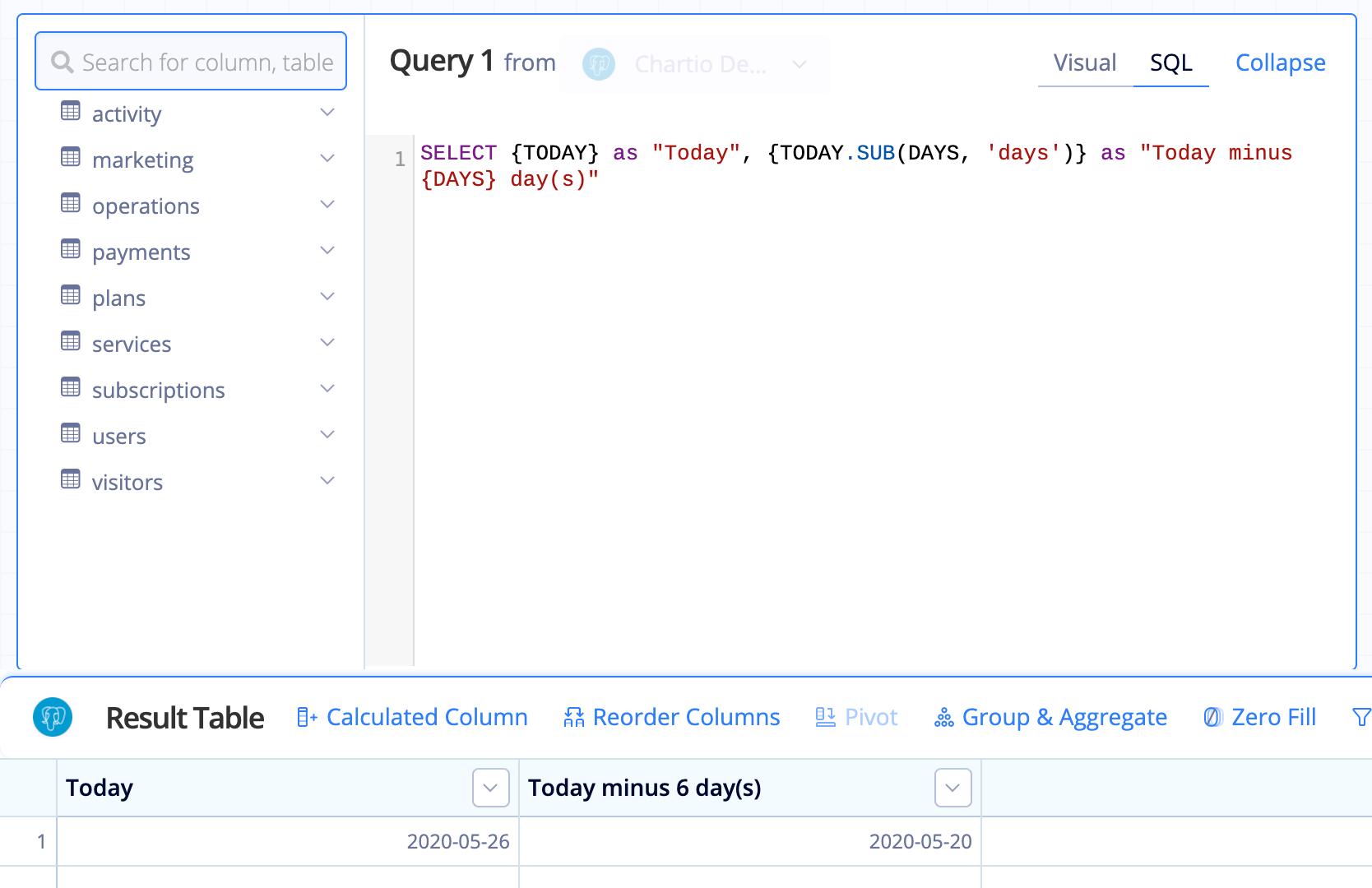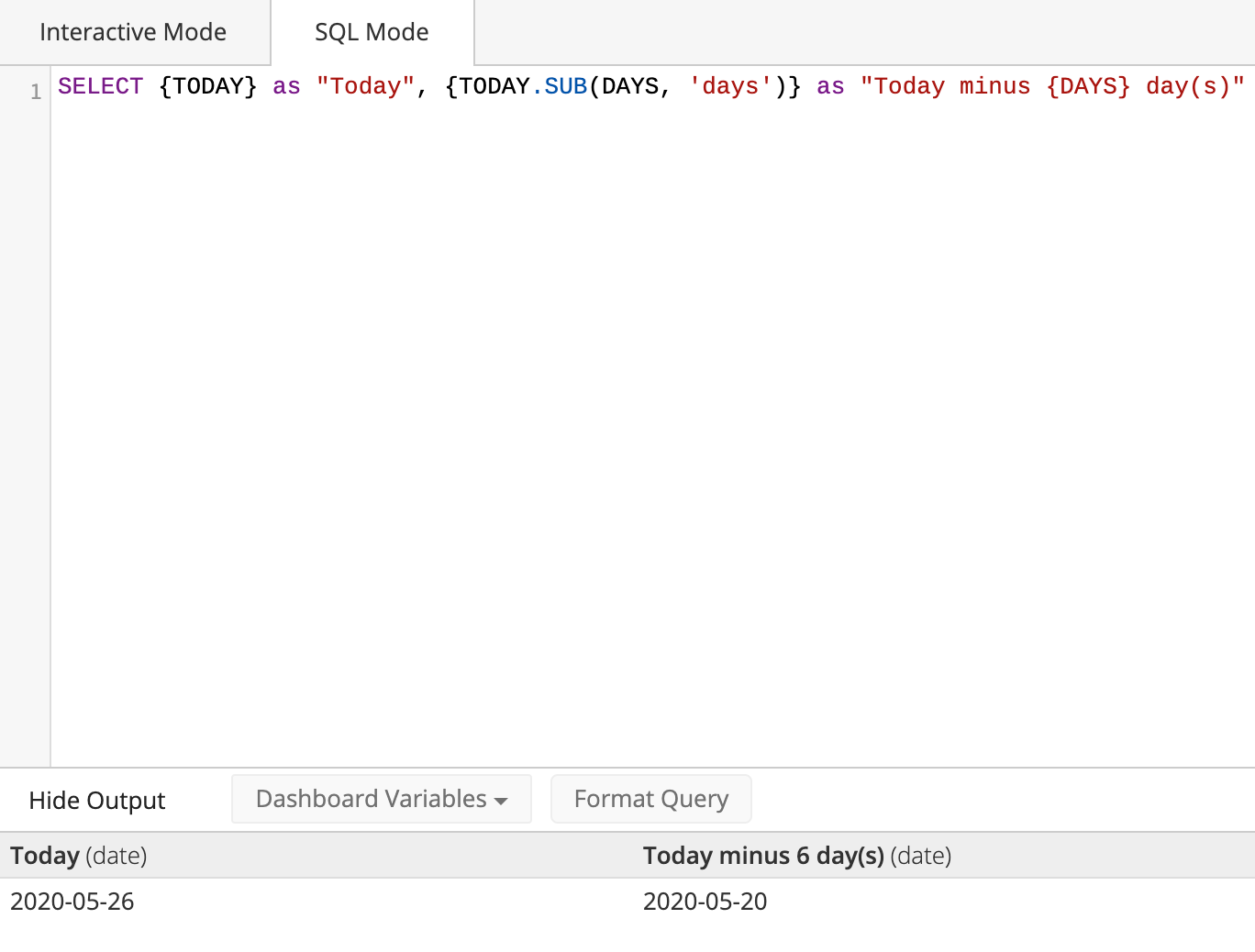Datetime Functions
Functions
You can perform functions on datetime Controls and variables, which allows you to customize the date returned to fit your needs.
Multiple functions can be chained together; see examples below.
To try these out in Chartio, open the Chart tab in SQL Mode and add SELECT before your date formula. For example:
SELECT {CURRENT_CALENDAR_YEAR.START.SUB(1,'day')}
Units
Units are used to perform calculations on dates (add or subtract) and extract part of a date (e.g., return only the year part of a date). They can be used in either singular or plural form and include:
- day
- week
- month
- year
- quarter (PART() only)
Add and subtract
Add/subtract from Relative Date Variables to create other dates. Use the following format:
{DATE_VARIABLE.ADD(integer,'units')}
{DATE_VARIABLE.SUB(integer,'units')}
For example, to get the first day of the previous month:
{CURRENT_MONTH.START.SUB(1,'month')}
Example output:
| {CURRENT_MONTH.START} | {CURRENT_MONTH.START(1, ‘month’) |
|---|---|
| 2020-03-01 | 2020-02-01 |
Add and subtract functions can be combined to customize dates.
Calculating the last day of the previous month
Let’s say it’s currently June. {CURRENT_MONTH.END.SUB(1, 'month')} will return 2016-05-30, because we’re subtracting one month from 2016-06-30.
To get the last day of the previous month, use the following instead, which simply gets the day before the first day of the current month:
{CURRENT_MONTH.START.SUB(1,'day')}
Extract part of a date
We have two functions for extracting part of a date: PART() and BUCKET(). PART() returns a number, and BUCKET() returns a date string.
PART()
PART() allows you to extract part of a date and returns it as a number that can be used in calculations. Use the following format:
{DATE_VARIABLE.PART('units')}
PART() examples
-
Return the quarter number of the current day:
{TODAY.PART('quarter')}Example output:
{TODAY} {TODAY.PART(‘quarter’)} 2020-03-30 1 -
Return the last day of the current month:
{CURRENT_MONTH.END.PART('day')}Example output:
{CURRENT_MONTH.END} {CURRENT_MONTH.END.PART(‘day’)} 2020-03-31 31 -
Return the current year in number form:
{TODAY.PART('year')}Example output:
{TODAY} {TODAY.PART(‘year’)} 2020-03-30 2020
BUCKET()
BUCKET() allows you to extract part of a date and returns it as a date string. Use the following format:
{DATE_VARIABLE.BUCKET('units')}
BUCKET() examples
-
Return the month and year of the previous month:
{CURRENT_MONTH.START.SUB(1,'month').BUCKET('month')}Example output:
{CURRENT_MONTH.START} {CURRENT_MONTH.START.SUB(1,’month’).BUCKET(‘month’)} 2020-03-01 2020-02 -
Return the ISO week date of the current day:
{TODAY.BUCKET('week')}Example output:
{TODAY} {TODAY.BUCKET(‘week’)} 2020-03-30 2020-W14 -
Return the quarter date of the current day:
{TODAY.BUCKET('quarter')}Example output:
{TODAY} {TODAY.BUCKET(‘quarter’)} 2020-03-30 2020-Q1
Controls nested in datetime functions
Referencing a Hidden Variable, Text Input, or some other applicable Control type within a datetime function requires you to omit the usual curly braces from the Control’s name.
For example, let’s say we have a Text Input called “DAYS” that takes in integer values and we want to use the Text Input value in a datetime function so we can dynamically select data created N days from today, where N is our Text Input value. Our function would look like this:
{TODAY.SUB(DAYS, 'days')}
| In the Visual SQL interface |
|---|
 |
| In the Data Explorer interface |
|---|
 |